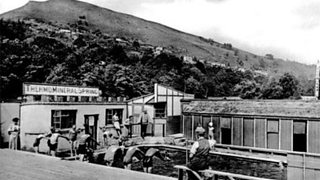September is a fabulous month for history, architecture and culture fans in Wales, as there are just under 700 Open Doors events taking place across the country - and they’re all free of charge.
������̳ Wales History has asked the to flag up just some of the many events taking place during September, but if you want to peruse all the hundreds of events you can explore the You may need to book to participate in some of the events.
Taff's Well thermal spring
Taff's Well thermal spring is the only thermal spring in Wales. The spring emerges on the eastern bank of the River Taff and has been contained within a brick well structure and building.

Taffs Well thermal spring
Nineteenth century dictionaries mention the reported medicinal properties of the water, especially for the cure of rheumatism, and women and men bathed there.
However, during the 19th century a weir was constructed across the River Taff which caused the widening of the river and moved it eastwards, causing floodwaters to often cover the spring.
At the beginning of World War One the well building fell into disrepair, but in 1929 the villagers of Taff's Well restored the well, which opened in 1930 complete with a small swimming pool.
In 1952 a large flood in the area resulted in the pool and well falling into disuse, and unlike other thermal springs in the UK such as Buxton or Bath, the water is at present not used for recreational use or water supply.
To learn more about Taffs Well thermal spring, its origins, its geology, its past as a Victorian health spa and the 'Grey Lady', join Gareth Farr () for an illustrated talk on Saturday 1 September 2012. See the for details.
If you have any memories, articles or photos of Taff's Well please bring them along for scanning into so that they may be preserved for future generations to view.
The Llangollen Railway
The Llangollen Railway is a mainly steam hauled heritage railway line starting at Llangollen Station beside the Dee River Bridge and continuing for seven and a half miles upstream, following the River Dee to the village of Carrog.

80072 travelling through the Dee Valley towards Carrog (Photo: David Wilcock)
The railway was reopened in 1975 by a group of enthusiasts who have slowly rebuilt the line, which had been closed to passenger traffic in 1965 and to goods in 1968 when much of the infrastructure, including signal boxes, was removed or demolished.
The station buildings of Llangollen, Berwyn and Carrog did, however, survive, and there are plans to extend the line a further two and a half miles to Corwen Town where a new station will be built.
Since the reopening of the Llangollen Railway a fully functioning engineering workshop has been built up. Its primary objective is to support and maintain the steam locomotives operating on the Llangollen Railway. The team at Llangollen are keeping traditional engineering alive and flourishing and can undertake a wider range of tasks including turning, milling, boring, welding and fabrication.
For Open Doors there will be four guided tours of the Engineering Works (Saturday 8 and Sunday 9 September 2012 – advance booking required).
Open Doors, part of European Heritage Days, which take place annually in 50 countries across Europe, is organised by the and supported by Cadw, the Welsh Government’s historic environment service. To find out about the full Open Doors 2012 programme visit the website .
